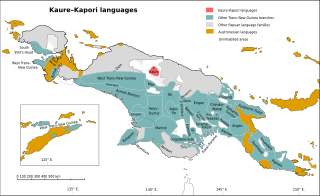Related Research Articles

The Papuan languages are the non-Austronesian languages spoken on the western Pacific island of New Guinea, as well as neighbouring islands in Indonesia, Solomon Islands, and East Timor. It is a strictly geographical grouping, and does not imply a genetic relationship.
The Border or Upper Tami languages are an independent family of Papuan languages in Malcolm Ross's version of the Trans–New Guinea proposal.
The Senagi languages are a small family of Papuan languages in the classification of Malcolm Ross, that had been part of Stephen Wurm's Trans–New Guinea proposal. They consist of the two languages Angor and Dera.
The Karkar language, also known as Yuri, is the sole Eastern Pauwasi language of Papua New Guinea. There are about a thousand speakers along the Indonesian border spoken in Green River Rural LLG, Sandaun Province.
Usku, or Afra, is a nearly extinct and poorly documented Papuan language spoken by 20 or more people, mostly adults, in Usku village, Senggi District, Keerom Regency, Papua, Indonesia.

More than 700 living languages are spoken in Indonesia. This figure indicates that Indonesia has about 10% of the world's languages, establishing its reputation as the second most linguistically diverse nation in the world after Papua New Guinea. Most languages belong to the Austronesian language family, while there are over 270 Papuan languages spoken in eastern Indonesia. The language most widely spoken as a native language is Javanese.
The Pauwasi languages are a likely family of Papuan languages, mostly in Indonesia. The subfamilies are at best only distantly related. The best described Pauwasi language is Karkar, across the border in Papua New Guinea. They are spoken around the headwaters of the Pauwasi River in the Indonesian-PNG border region.
Kembra is a South Pauwasi language spoken in Western New Guinea by some twenty persons in Kiambra village, Kaisenar District, Keerom Regency. It is used by between 20% and 60% of the ethnic population and is no longer passed down to children.
Molof is a poorly documented Papuan language spoken by about 200 people in Molof village, Senggi District, Keerom Regency.
Tofanma or Tofamna is a poorly documented Papuan language of Indonesia. Wurm (1975) placed it as an independent branch of Trans–New Guinea, but Ross (2005) could not find enough evidence to classify it. It appears to be related to Namla, a neighboring language.
Namla is a poorly documented Papuan language of Indonesia. It appears to be related to Tofanma, a neighboring language. It is spoken in Namla village, Senggi District, Keerom Regency.

Kaure is a Papuan language of West Papua. It is spoken in the villages of Lereh, Harna, Wes, Masta, and Aurina.
Yetfa and Biksi are dialects of a language spoken in Jetfa District, Pegunungan Bintang Regency, Highland Papua, Indonesia, and across the border in Papua New Guinea. It is a trade language spoken in Western New Guinea up to the PNG border.
Tebi, also known by the village name Dubu, is a Western Pauwasi language of West New Guinea. It is spoken in Affi, Dubu, and Jembatan Web villages of Keerom Regency. It is mostly used by older adults.
Yafi, also known as Zorop, is an Eastern Pauwasi language of West New Guinea. It is spoken in Warlef village, Senggi District, Keerom Regency.
The Namla–Tofanma languages are a small family of languages of New Guinea, consisting of Namla and Tofanma. Usher (2020) classifies them as a branch of the West Pauwasi languages. Foley (2018) classifies them as an independent language family.
The South Pauwasi languages are a likely small language family of New Guinea, potentially consisting of Yetfa, Kimki, Lepki, Murkim and Kembra.
The East Pauwasi languages are a family of Papuan languages spoken in north-central New Guinea, on both sides of the Indonesia-Papua New Guinea border. They may either form part of a larger Pauwasi language family along with the Western Pauwasi languages, or they could form an independent language family.
The Lepki–Murkim languages are a pair to three recently discovered languages of New Guinea, Lepki, Murkim and possibly Kembra.
The Tebi–Towe languages, Wurm's West Pauwasi languages, are a pair of closely related languages of New Guinea, namely Tebi (Dubu) and Towei.
References
- ↑ Foley, William A. (2018). "The Languages of the Sepik-Ramu Basin and Environs". In Palmer, Bill (ed.). The Languages and Linguistics of the New Guinea Area: A Comprehensive Guide. The World of Linguistics. Vol. 4. Berlin: De Gruyter Mouton. pp. 197–432. ISBN 978-3-11-028642-7.
- ↑ New Guinea World